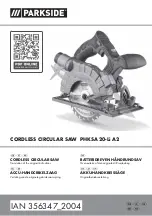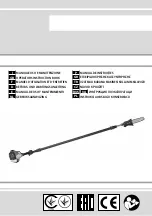
POWX07590
EN
Copyright © 2019 VARO
P a g e
|
8
www.varo.com
The base frame (12) consists of four table legs with cross braces that must be mounted.
Required tools:
2 combination spanners
▪
Attach the four table legs to the corners of the saw table. Note that the legs on the rear
must be mounted so that the holes for the assembly of the tilt protection devices face the
rear of the machine.
▪
Mount the cross braces (A) on the front and rear between legs 12.
▪
Mount the cross braces (A) on the sides between legs 12.
Do this by attaching each cross brace on the inside to each table leg with two screws, washers
and locking nuts.
▪
Push the rubber feet (16) onto the supporting legs.
▪
Finally, fit the four brackets with the table extension and the table legs.
The brackets are fitted through the screw holes in the housing.
Note: Only place the device on a level, skid-proof surface. The device must
not wobble.
8.2
Attaching the tilt protection (Fig. 2)
▪
There is a nut (b) onto the foot pad (a) which can be adjusted length of engagement,
rotate the nuts (b) and locate them on the suitable position of threaded rod, mount the foot
pad onto the hole of each auxiliary support (c).
▪
Put end of auxiliary support (c) onto the leg (d), insert two bolts through the aligned
mounting holes of the leg (d) and brace (e), attach washers, spring washers and nut to the
bolts and tighten two nuts.
Note: the auxiliary supports must be mounted at the back of table saw to
avoid the risk of falling over when in operation.
8.3
Fitting the parallel fence (Fig. 3)
▪
Place the parallel fence (11) to the desired position on the table, insert the bolts of lock
knobs (9) through the both ends (c) of parallel fence, through the table (18) and then fix
them together with the clamping plate (b).
▪
To adjust the position of the fence, loosen the lock knobs (9) at both ends and slide the
parallel fence along the work table. Once position is adjusted, tighten the lock knobs to
lock the fence in place.
Make sure fence is perfectly parallel to the blade and completely locked in
place to prevent kickback.
Do not use parallel fence when cutting across wood grain (crosscutting).
8.4
Mounting mitre angle stop (Fig. 4)
The mitre angle stop (11) consists of two parts - the stop plate (A) and the angle adjustment (B)
that must be assembled together.
▪
Insert the stop plate (A) into the gaps of the angle adjustment (B) with both adjusting
screws (C), push into the required position and tighten the adjusting screws.
Push the gliding bar (D) of the mitre angle stop into the required bar of the table surface.
Right-handed operators prefer to push the mitre angle stop into the left bar
of the table surface.

































